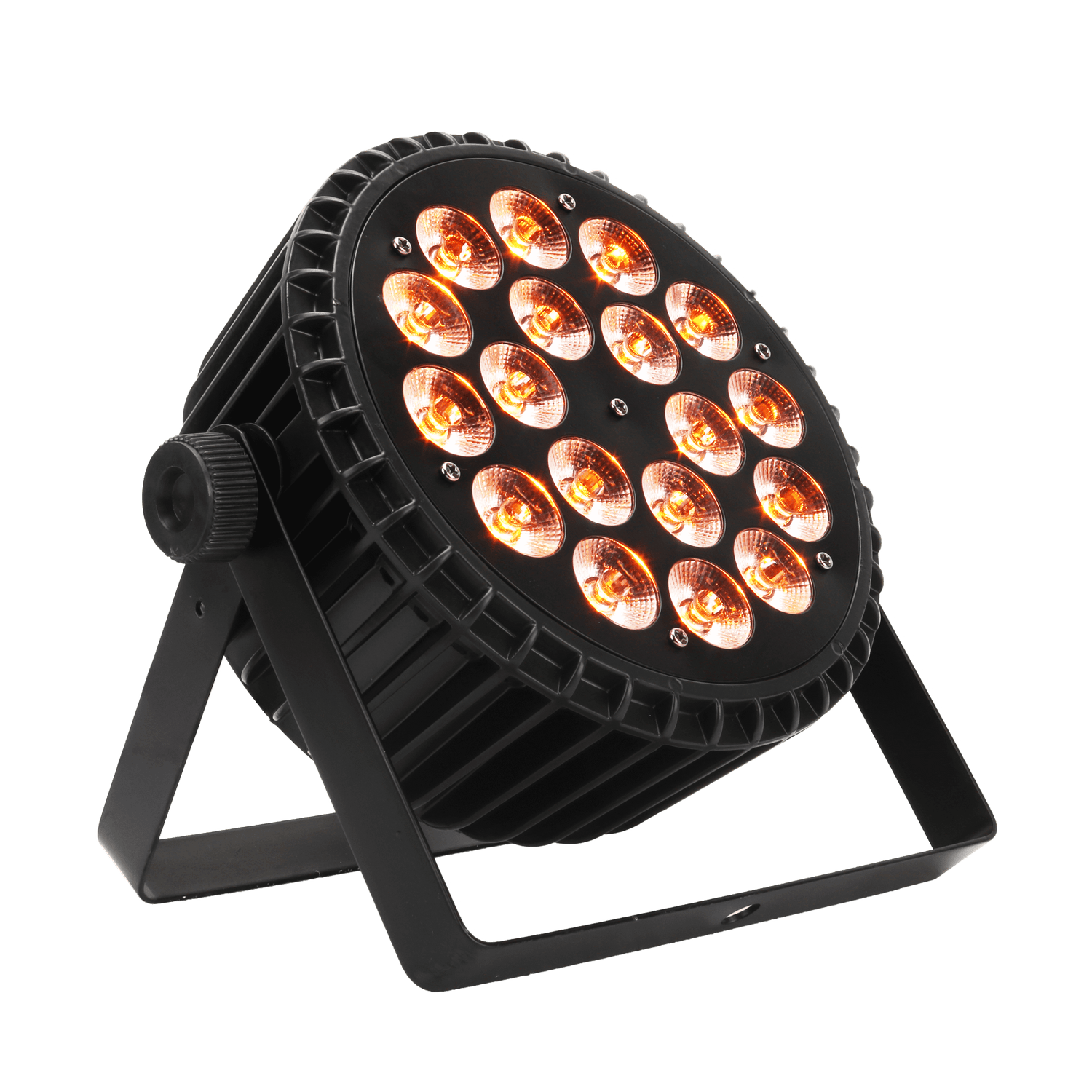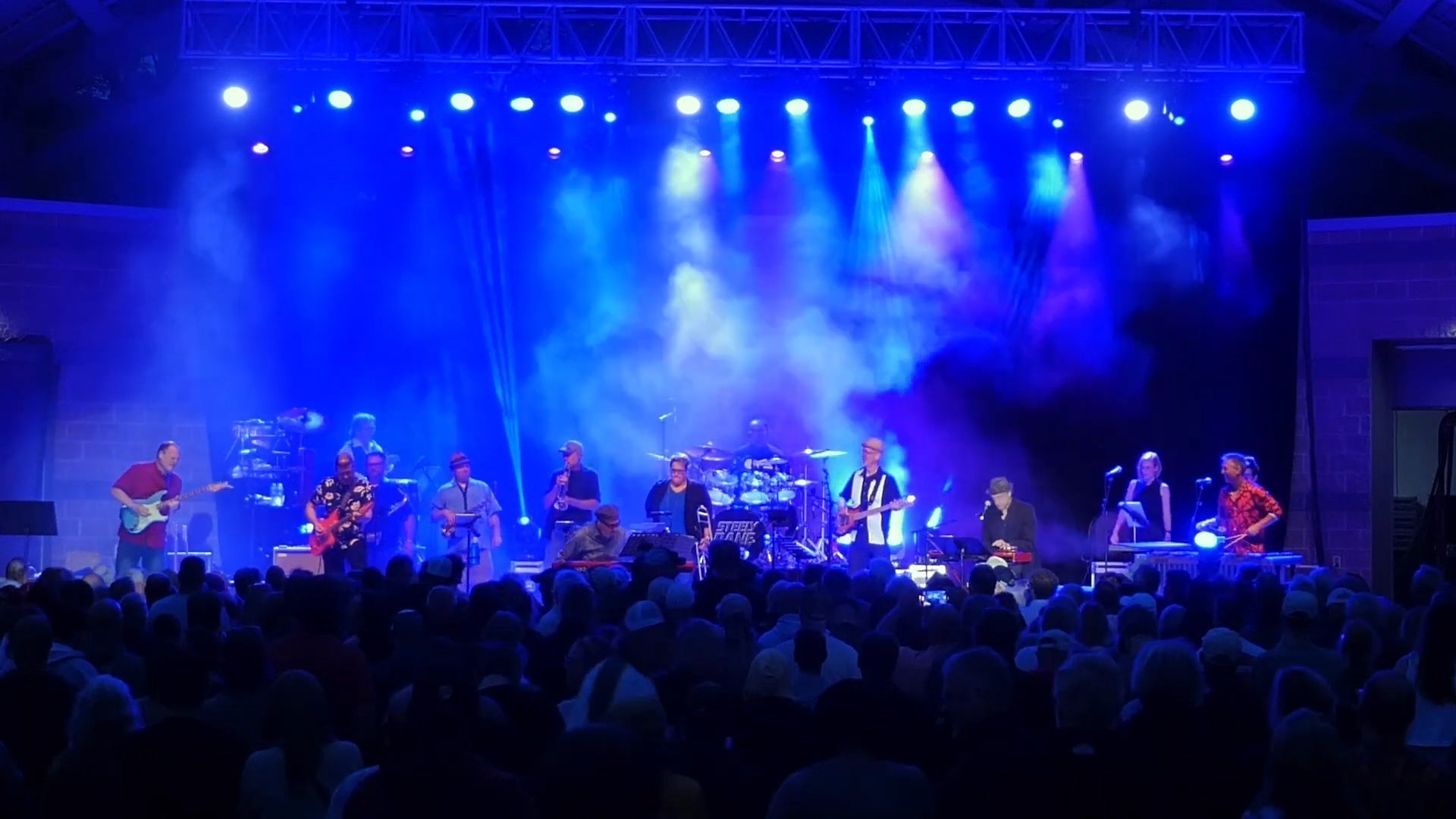¿Alguna vez has estado sentado entre el público, sintiendo el ritmo de la música o la tensión de una obra de teatro, y has notado cómo los colores del escenario parecían bailar? Gran parte de ese efecto dramático viene de un grupo de luces todoterreno llamadas focos PAR. Si todo este equipo de iluminación te resulta desconocido, estás en el lugar indicado.
En este contenido, explicaremos qué son las luces PAR, cómo funcionan y te daremos consejos sencillos para usarlas como un profesional.
¡Pasemos a lo básico!
¿Qué son las luces PAR?

Las luces PAR, abreviatura de lámparas de reflector aluminizado parabólico (Parabolic Aluminized Reflector), se han ganado su lugar como elementos básicos en escenarios y eventos.
Con sus haces estrechos y contundentes, se han convertido en favoritas en festivales de música, temporadas de teatro, fiestas en clubes, lugares de culto e incluso en fachadas de edificios.
El nombre proviene de la ingeniosa forma que hay dentro de cada luminaria. El reflector parabólico rebota la luz de la bombilla en un único haz frontal que se mantiene brillante incluso en los bordes.
Ese diseño le da al foco PAR su característico baño de luz plano, perfecto para lanzar color sobre un escenario amplio o resaltar a un solo actor con una luz blanca cristalina.
Y aunque los cabezales móviles modernos pueden girar y hacer zoom con un toque en la pantalla, una luz PAR se mantiene refrescantemente sencilla: conéctala, ajusta el color o la intensidad y mira cómo la escena cobra vida. Las luces PAR pueden resaltar a un cantante solista, bañar un escenario en color intenso o aportar ambiente a un decorado.
Cómo funcionan las luces PAR
Cada luminaria emite un haz estrecho y potente. Un reflector parabólico dirige esa luz hacia adelante y una lente esculpe su borde. En las unidades LED modernas, diminutos chips generan colores intensos por sí solos, por lo que no se necesitan gelatinas. En los PAR halógenos tradicionales, se colocan geles de color delante para añadir el efecto.
Un vistazo rápido a la anatomía de una luz PAR
Desglosar una unidad PAR muestra por qué funciona tan bien:
- Lámpara (bombilla): El corazón interno, ya sea una bombilla halógena o un conjunto de LEDs brillantes.
- Reflector: Este espejo curvo se sitúa detrás de la lámpara y empuja la mayor parte de la luz hacia adelante.
- Lente: Ubicada al frente, decide si el haz es estrecho, medio o amplio.
- Caja o carcasa: Una carcasa metálica resistente que protege la bombilla y mantiene unida la luminaria.
- Yugo (soporte de montaje): Un robusto marco en U que permite colgar la luz y orientarla con precisión.
Algunos modelos incluyen ranuras para geles de color, mini viseras (barn doors) para dar forma al haz e incluso pequeños ventiladores silenciosos para mantener la temperatura bajo control.
¿Por qué son tan populares las luces PAR?

Las luces PAR se han ganado un puesto permanente en el mundo del espectáculo, y con razón:
- Versatilidad: Lo bastante amigables para baños de luz de escenario completo, contraluces agresivos, sutiles toques arquitectónicos o iluminación ascendente alegre en bodas.
- Durabilidad: Cuerpos metálicos robustos que soportan cargas constantes en viajes con baches y hasta algún chaparrón en eventos al aire libre.
- Simplicidad: Su diseño plug-and-play hace que tanto técnicos novatos como diseñadores experimentados recurran a ellas.
- Precio asequible: Rendimiento sólido sin arruinarte, por lo que hoy encajan en casi cualquier presupuesto.
- Compatibilidad: Contrólalas con una mesa DMX o un controlador manual, y obedecen.
Conviven sin problemas en la parrilla con cabezales móviles o focos tipo spot, formando el “pegamento” que une un sistema de iluminación moderno.
¿Buscas más tendencias en iluminación escénica? Lee Las principales tendencias en iluminación de escenarios para 2025 (10 ideas modernas de iluminación escénica)!
Tipos comunes de luces PAR
Aun así, no todas las PAR sirven para todo. Estos son los principales tipos que debes conocer:
1. Luces PAR tradicionales (con halógeno)
Las de batalla usan una bombilla halógena y una luz cálida y agradable que encanta a los actores. Aunque consumen muchos vatios, su alcance atraviesa la niebla del escenario como pocos chips LED pueden hacerlo.
- Ventajas: Haz intenso, relleno frontal sencillo y precio al alcance de cualquier empresa de alquiler.
- Mejor uso: Teatro tradicional, espectáculos de estilo retro.
2. Luces PAR LED
Las PAR LED son la versión moderna. En lugar de un filamento de vidrio, incorporan chips RGB o RGBW, de modo que obtienes cientos de tonos sin necesidad de gelatinas.
- Ventajas: Consumen menos energía, mezclan colores internamente, se mantienen frías y duran años.
- Mejor uso: Conciertos, eventos, equipos móviles de DJ y equipos con conciencia ecológica.
3. Barras PAR o tiras PAR
Una fila de PAR LED montada en una sola barra. Perfectas para bañar paredes o realzar un telón de fondo con luz uniforme.
Mejor uso: Bodas y clubes, ferias comerciales y eventos de moda.
4. Luces PAR a batería
Estas luminarias inalámbricas te dan total libertad. Cárgalas, colócalas y olvídate de los cables.
Mejor uso: Eventos improvisados, ubicaciones remotas, espacios alquilados y funciones al aire libre.
Tamaños de luces PAR: ¿qué significan PAR38, PAR56 y PAR64?
Esos números indican el diámetro de la bombilla en octavos de pulgada:
- PAR38: 4,75 pulgadas
- PAR56: 7 pulgadas
- PAR64: 8 pulgadas
Un número mayor equivale a un haz más amplio y potente.
- PAR38: Perfectas para salas pequeñas y trabajos de acento.
- PAR56: Buena cobertura para escenarios medianos.
- PAR64: Luz amplia y contundente para arenas y grandes espectáculos.
Comprender esta escala ayuda a planificar el nivel de brillo, el área de cobertura y la distancia.
Ángulos de haz: ¿spot, medio o flood?
Para lograr tus objetivos de iluminación, la apertura del haz es importante. Diferentes lentes o reflectores ofrecen ángulos distintos:
- Narrow Spot (NSP): Luz estrecha y contundente que resalta a intérpretes u objetos concretos.
- Medium Flood (MFL): Cobertura uniforme que baña de color sin perder detalle.
- Wide Flood (WFL): Para grandes superficies como telones, techos o fondos.
Como siempre en diseño de iluminación, al elegir los ángulos de haz piensa en el tamaño del recinto y en la atmósfera que quieres crear.
¿Dónde usar luces PAR en el escenario?

1. Iluminación frontal
Las luminarias en el borde del escenario iluminan rostros y vestuario. Hacen que los intérpretes destaquen y mantienen la atención del público en ellos.
2. Contraluz
Colocadas detrás del elenco, estas luces recortan siluetas y crean halos dramáticos. Atraen al espectador a la escena y añaden tridimensionalidad.
3. Iluminación lateral
Los haces que flanquean el escenario siguen cada movimiento, especialmente en piezas de danza. Los ángulos laterales dan forma al movimiento y ayudan a resaltar líneas y posturas.
4. Baños de luz cenitales
Las luminarias colgadas arriba empapan toda el área con luz uniforme. Perfectas para ambientes suaves, transiciones o cualquier momento que requiera color sencillo pero fiable.
Cómo controlar las luces PAR
Controlar la luz te permite diseñar la experiencia:
Control manual
Interruptores básicos de encendido/apagado o reguladores de intensidad. Fáciles de usar, sobre todo en montajes estáticos.
Control DMX
DMX (Digital Multiplex) te permite dar forma al ritmo y la sincronía. Puedes coordinar cambios de luz con la música, automatizar escenas o hacer fundidos de color.
La mayoría de las PAR LED admiten varios canales DMX para color, efectos, brillo y sincronización cromática. Aprender DMX abre un gran abanico de posibilidades creativas.
Elegir las luces PAR adecuadas
|
Tipo de evento |
Tipo de PAR recomendado |
|
Locales pequeños |
PAR38 LED compacto |
|
Conciertos en vivo |
PAR64 con DMX |
|
Obras de teatro |
PAR56 halógeno o PAR64 LED |
|
Bodas |
Barras PAR LED a batería |
|
Instalaciones artísticas |
PAR LED con mezcla de color |
P. D. Como siempre, revisa el flujo luminoso (lúmenes), el ángulo de haz, la gama de color y el hardware de montaje.
Cómo montar luces PAR: consejos para principiantes
Aquí tienes una lista de comprobación sencilla para el montaje:
- Planifica tu distribución: dibuja las zonas de iluminación: frontal, trasera y laterales.
- Monta con seguridad: usa pies de iluminación o estructuras y revisa dos veces las abrazaderas.
- Ajusta con precisión: prueba varios ángulos para captar los puntos focales principales.
- Colorea tu escena: geles para halógeno o tonos predefinidos en LEDs.
- Conecta la alimentación: equilibra los circuitos y mantén los cables ordenados.
- Conecta DMX si es necesario, direcciona cada luminaria y programa las escenas.
- Recorre todas las señales de luz antes de la transmisión o de levantar el telón.
Consejos de mantenimiento y seguridad
Mantén tus luces como nuevas:
- Limpia con regularidad: Pasa un paño de microfibra seco por las lentes.
- Revisa las conexiones: Asegura cada enchufe y sustituye cualquier cable pelado.
- Deja que se enfríen: Espera antes de manipular bombillas halógenas calientes.
- Guarda correctamente: Transporta el equipo en estuches acolchados; no apiles objetos pesados encima.
- Actualiza el firmware (para PAR LED): Instala cualquier software nuevo.
Iluminación ecológica: pásate al LED
Las PAR LED son equipo moderno y también ecológico. Consumen alrededor de un 80 % menos de energía, se mantienen frías y brillan durante miles de horas. Eso reduce las facturas de luz, los costes de climatización y las visitas a la tienda de suministros.
Como resultado, muchos recintos están cambiando todo a LED para reducir residuos y ahorrar dinero a largo plazo. Si estás diseñando un sistema nuevo, empieza por ahí.
Reflexiones finales
Los focos PAR pueden parecer sencillos, pero transforman suelos desnudos en escenarios pulidos sin necesidad de equipos caros. Tanto si estás iluminando a una banda, a un elenco teatral o un club, estas pequeñas luminarias ofrecen cobertura flexible y colores llamativos.
A medida que ganes confianza, podrás combinar ángulos de haz, añadir un controlador y disparar looks personalizados que encajen con cada momento.
Tu aventura puede empezar con una sola unidad, así que consigue una lámpara PAR, conéctala y mira cómo tus ideas salen a la luz. ¿No sabes qué marca elegir? ¡Nosotros te ayudamos! Descubre más en Las 10 mejores marcas de iluminación escénica en 2025 (Guía de compra).
Preguntas frecuentes
¿Qué significa PAR en iluminación?
Significa Parabolic Aluminised Reflector (reflector aluminizado parabólico) y describe el diseño de la lámpara.
¿Las luces PAR son adecuadas para principiantes?
Sin duda: son sencillas, económicas y se integran fácilmente en la mayoría de los sistemas.
¿Puedo usar luces PAR en exteriores?
Sí, siempre que tengan un grado de protección IP contra agua y polvo.
¿Cuántas luces PAR necesito para un escenario pequeño?
Aunque cada escenario es ligeramente distinto, entre cuatro y seis focos PAR LED suelen cubrir bien el área.
¿Necesito un controlador para las luces PAR LED?
Si quieres fundidos suaves, secuencias rápidas o cambios de color instantáneos, una mesa DMX básica te permitirá ejecutar esas escenas.
¿Cuánto duran las PAR LED?
La mayoría de las unidades modernas duran entre veinticinco mil y cincuenta mil horas, por lo que superan con creces a las bombillas antiguas.
¿Puedo mezclar diferentes tamaños de PAR en un mismo sistema?
Claro que sí. Solo asegúrate de que la colocación de cada luz tenga en cuenta la apertura del haz y la intensidad.









